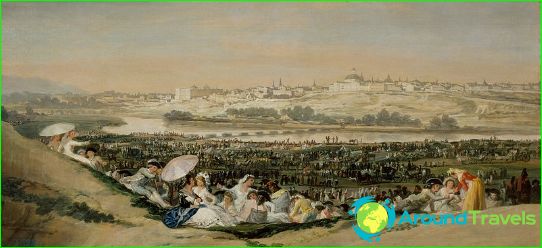History of Madrid

Madrid is the capital and largest city of Spain, as well as an important economic, political and cultural center of Europe. The city is located in the central part of the Iberian Peninsula on the Manzanares River.
The results of archaeological excavations have shown that the first settlements on the lands of today's Madrid and its surroundings existed in prehistoric times. During the work, the remains of the settlements of the Celtic tribe of the Carpetans, Roman villas, a basilica and three Visigoth necropolises were also discovered. Nevertheless, the first written mentions of the existence of the city here date back only to the second half of the 9th century and from that moment, in fact, it is customary to count the history of modern Madrid..
The city grew up around the Alcazar fortress built by the Emir of Cordoba Mohammed I on a promontory near the Manzanares River, on the border between the Muslim Al-Andalus and the kingdoms of Leon and Castile, in order to protect Toledo from possible Christian invasions. After the collapse of the Caliphate of Cordoba, Madrid joined Typha Toledo.
In 1085, Toledo capitulated to the army of King Alfonso VI the Brave, and Madrid came under the control of Castile. Soon Madrid received a number of powers and privileges, which, undoubtedly, positively affected its further development and the growth of political influence and economic potential..
Capital city
In 1561, Philip II decided to move the capital of the kingdom from Valladolid to Madrid, thereby initiating its heyday and largely predetermining the future fate of the city. The next hundred years can be noted as one of the most intense periods of development in the history of Madrid, including its cultural growth (largely thanks to such recognized geniuses as Lope de Vega, Miguel de Cervantes, Diego Velazquez, Francisco de Queveda, etc. ).
At the beginning of the 18th century, the throne passed to the founder of the Spanish line of Bourbons - Philip V. The era of Bourbon rule became significant for Madrid, and the representative of the Charles III dynasty went down in history as the "best ruler" of Madrid, turning the city into a real "model of the European capital" of that time. During this period, the Royal Academy, Library, Observatory were founded, as well as a new Royal Palace, Royal factories for the production of glass, porcelain and carpets, and much more. Special attention in the global development and modernization of the city was paid to street lighting and sewerage systems.
In 1808, Napoleon's troops invaded the city, which led to the start of the Spanish Revolution, which ended in 1814 with the victory of Spain. The struggle for independence led to some stagnation in the development of Madrid, but already during the reign of Isabella II, its rapid growth was noted. The city underwent major changes in the architectural appearance in the late 19th - early 20th centuries.
Despite the devastating consequences of the Spanish Civil War of 1936-1939, the economic boom of 1959-1973, which went down in history as the "Spanish Miracle", brought an unprecedented economic recovery and the development of the tourism industry to Madrid..
Today Madrid is considered to be one of the most beautiful capitals in Europe with a host of cultural and architectural attractions. One of the most popular and spectacular events in Madrid is undoubtedly Tavromachia - the ancient name of bullfighting, or bullfighting, whose history dates back to the Bronze Age..
Pictures of Madrid
Coat of arms of madrid
Madrid in a painting by Francisco Goya (1788)
Royal Palace
Cathedral of Santa Maria la Real de la Almudena
Monastery of Encarnacion
Plaza Mayor
Gran Via
Retiro park
 Madrid in a painting by Francisco Goya (1788)
Madrid in a painting by Francisco Goya (1788) Royal Palace
Royal Palace Cathedral of Santa Maria la Real de la Almudena
Cathedral of Santa Maria la Real de la Almudena Monastery of Encarnacion
Monastery of Encarnacion Plaza Mayor
Plaza Mayor Gran Via
Gran Via Retiro park
Retiro park

